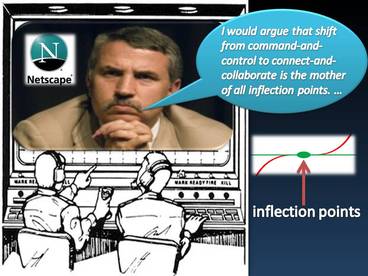digitalsandbox
- Digital Sandbox
- About Mike King
- The Web 2.0 Generation
- The ePub Generation:
- Cyber Bullying Prevention
- Art of Digital Storytelling
- Creative Commons
- New Paradigms
- Common Core Transition
- Collaboration Tools
- Language Literacy Tools
- Adopting Technology
- Flipped Classroom
- Flipped Classroom Design
- Scaffolding Flipped Classrooms
- Avatars Flipped Classroom
- Flipped InfoGraphic
- 21st Century Teaching
- Knowledge Management
- STAR
- Acceptable Use Policy
- Live Poll
Past or Present Paradigms of Thinking
|
In every story there is a story line and what keeps the story line interesting is the back stories. Today we are going to tell the story of Adopting Technology into the Common Core. We are also going to tell the back stories of how students will learn best in the Common Core. These back stories will be about inflection points, and past or present paradigms of thinking. The back stories will be about thinking outside of the box for a new generation, a new generation of learners who will be asked to perform authentically while thinking abstractly. The 21st Century of Learners, "The Net Generation"
|
Inflection Points

Let's take one example of an inflection point as it might be related to the future. This back story concerns the launching of Netscape as Thomas Friedman points out the importance of “inflection points” in history. You know, inflection points, the point in a curve at which it changes direction from convex to concave, or vice versa. Friedman states in his book entitled the World is Flat that when Netscape was launched “We went from a world where value was created in vertical silos of command and control to one in which value is created horizontally on this platform by who you connect and collaborate with… I would argue that shift from command-and-control to connect-and-collaborate is the mother of all inflection points. … It is the biggest event, I would argue, to change human beings and how they interact, since Guttenberg invented the printing press.” Now how does this back story on inflection points relate to the plot of our story -- Education is at an inflection point – a strategic opportunity to change course or direction.
New Paradigms

We are now introduced to the next back story of a paradigm, a paradigm of dysfunctional proportions , the idea of accountability as established through No Child Left Behind. A paradigm is a set of rules and regulations that does two things: (1) it establishes boundaries; and (2) it tells you how to behave inside the boundaries in order to be successful. But what if the paradigm is wrong? What if the boundaries that are set for you are out of proportion to how you measure success? In this case the back story of No Child Left Behind.
In April of 2011 the National Center for Fair & Open Testing concluded that practices implemented through NCLB have been unsuccessful. NCLB has not succeeded, with rare exception, in even maintaining the previous rates of improvement. In a recent June 13th, 2011 article of "eSchool News" the Secretary of Education, Arne Duncan, was reported as saying, "that 82 percent of U.S. schools could be labeled failures in the year 2012 if No Child Left Behind isn’t changed." This statement only reinforces popular opinion that the majority predict that no one state will meet the law’s goal of having 100 percent of students proficient in math and reading by 2014.
These statements of predicted failure for public education under the NCLB Act is articulated in another way in terms of lack of authenticity in an article November 2008 article “Why Rising Test Scores May Not Equal Increased Student Learning.” In the article, author David Berliner states, "It is not uncommon for 20-60 school days per year to be spent in test-preparation activities. Children trained to answer questions are drilled on items that will appear on their test. But that is not education. It is training. It is less clear that any authentic learning has occurred.” Have we now after ten years of struggling with the reality of the first paradigm, finally came to grips that the educational system is in fact, in need of reauthorization?
In April of 2011 the National Center for Fair & Open Testing concluded that practices implemented through NCLB have been unsuccessful. NCLB has not succeeded, with rare exception, in even maintaining the previous rates of improvement. In a recent June 13th, 2011 article of "eSchool News" the Secretary of Education, Arne Duncan, was reported as saying, "that 82 percent of U.S. schools could be labeled failures in the year 2012 if No Child Left Behind isn’t changed." This statement only reinforces popular opinion that the majority predict that no one state will meet the law’s goal of having 100 percent of students proficient in math and reading by 2014.
These statements of predicted failure for public education under the NCLB Act is articulated in another way in terms of lack of authenticity in an article November 2008 article “Why Rising Test Scores May Not Equal Increased Student Learning.” In the article, author David Berliner states, "It is not uncommon for 20-60 school days per year to be spent in test-preparation activities. Children trained to answer questions are drilled on items that will appear on their test. But that is not education. It is training. It is less clear that any authentic learning has occurred.” Have we now after ten years of struggling with the reality of the first paradigm, finally came to grips that the educational system is in fact, in need of reauthorization?
|
Now that leads us back to the plot of the story and its most essential question, "What is reauthorization?" Reauthorization is simply moving away from the first paradigm as we are now in a paradigm shift. A paradigm shift is discovering problems that we cannot solve which triggers a catalyst in new ways of thinking.
Thinking the Common Core way. A way to reach success for all as it is defined in college and career readiness. Yet we know that in every paradigm shift begins a new set of problems. It is the special set of problems that everyone in the field wants to be able to solve. But in the shift it becomes very complex in that no one has a clue as how to solve it. |
|
|
Today's Meet will be used at Podstock 2011 as an
interactive tool to demonstrate how students can ask questions digitally in a forum for the class to view. Here are a few ways we've used it in the classroom. |
